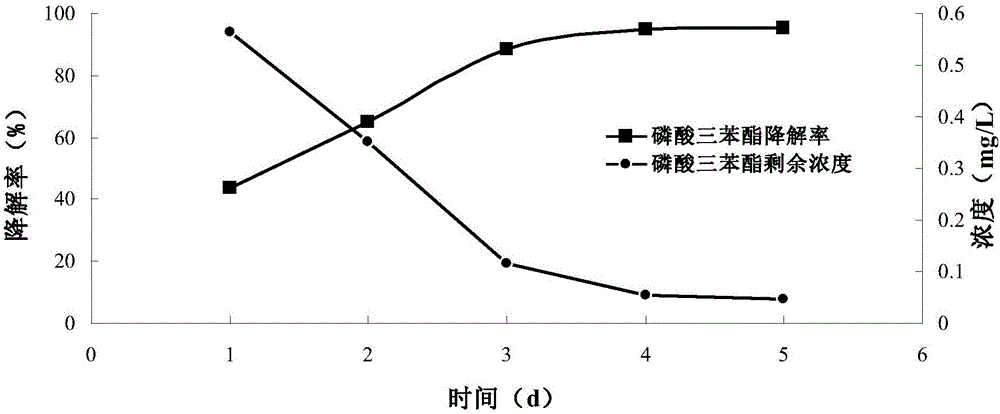Method for degrading triphenyl phosphate through brevibacillus brevis and application thereof
A technology of Bacillus brevis and triphenyl phosphate, applied in chemical instruments and methods, water treatment of special compounds, water pollutants, etc., can solve problems such as low efficiency, achieve low cost, good degradation effect, and environmental adaptability strong effect
- Summary
- Abstract
- Description
- Claims
- Application Information
AI Technical Summary
Problems solved by technology
Method used
Image
Examples
Embodiment 1
[0023] 1. Screening of degrading strains
[0024] (1) Collect the sediment in the water body of the polluted site, weigh 1g of the sediment sample, add it to the enrichment medium containing triphenyl phosphate with a concentration of 5mg / L, and cultivate it in a constant temperature shaker at 30°C and 150rpm. The main components of enrichment medium are: 5g / L beef extract, 10g / L peptone, 5g / L NaCl, 1000 mL distilled water, pH 7.0.
[0025] (2) Transfer once every 2 days, increase the concentration of triphenyl phosphate by 5mg / L at the same time of each transfer, until the concentration of triphenyl phosphate reaches 40mg / L, inoculate with 40mg / L triphenyl phosphate ester as the only carbon source in inorganic salt medium. The main components of the inorganic salt medium are: 1g / L NH 4 NO 3 , 1.5 g / L KH 2 PO 4 , 3 g / L K 2 HPO 4 , 40 mg / L triphenyl phosphate, 2mL / L trace element solution, 1000mL distilled water, pH 7.0. The composition of trace elements is: 4g / L MgSO ...
Embodiment 2
[0032] Example 2 Degradation analysis of Bacillus brevis to triphenyl phosphate
[0033] Inoculate Bacillus brevis into a 1000mL Erlenmeyer flask containing 500mL of sterilized enrichment medium, place it in a constant temperature shaker at 30°C, 150rpm, and cultivate for 24h. The main component of the enrichment medium is: 5g / L beef extract, 10g / L peptone, 5g / L NaCl, 1000 mL distilled water, pH 7.0.
[0034] Place the enriched cultured bacterial solution in a 50mL sterilized centrifuge tube at 6000 g After centrifugation at the speed of 5 min, the bacteria were collected and washed repeatedly with sterile normal saline and centrifuged for 3 times, and finally added normal saline to make a certain concentration (OD 600 =0.6) of bacterial suspension, add 1mL of prepared bacterial suspension into 19mL of sterilized degradation medium for degradation experiment, 30℃, 150rpm, after 5 days of incubation, the sample is determined by GC-MS, analysis Degradation effect of bacteria...
Embodiment 3
[0053] Same as Example 2, except that during the enrichment culture process, the pH of the enrichment medium is 6.5, the culture conditions are: the temperature is 20°C, the rotation speed of the shaker is 120 rpm, and the culture time is 16h, and finally Bacillus brevis triphenyl phosphate The degradation rate of ester was 94.8%.
PUM
 Login to View More
Login to View More Abstract
Description
Claims
Application Information
 Login to View More
Login to View More - R&D
- Intellectual Property
- Life Sciences
- Materials
- Tech Scout
- Unparalleled Data Quality
- Higher Quality Content
- 60% Fewer Hallucinations
Browse by: Latest US Patents, China's latest patents, Technical Efficacy Thesaurus, Application Domain, Technology Topic, Popular Technical Reports.
© 2025 PatSnap. All rights reserved.Legal|Privacy policy|Modern Slavery Act Transparency Statement|Sitemap|About US| Contact US: help@patsnap.com


